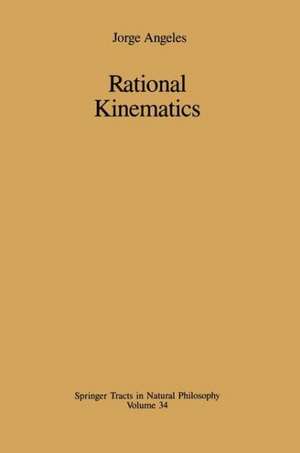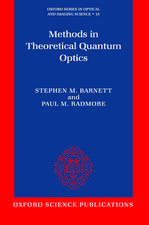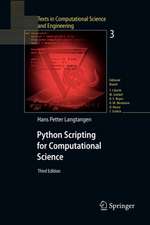Rational Kinematics: Springer Tracts in Natural Philosophy, cartea 34
Autor Jorge Angelesen Limba Engleză Paperback – 8 oct 2011
Din seria Springer Tracts in Natural Philosophy
-
 Preț: 378.92 lei
Preț: 378.92 lei -
 Preț: 389.88 lei
Preț: 389.88 lei -
 Preț: 376.22 lei
Preț: 376.22 lei -
 Preț: 489.59 lei
Preț: 489.59 lei -
 Preț: 383.33 lei
Preț: 383.33 lei -
 Preț: 386.61 lei
Preț: 386.61 lei -
 Preț: 386.00 lei
Preț: 386.00 lei -
 Preț: 383.33 lei
Preț: 383.33 lei -
 Preț: 378.34 lei
Preț: 378.34 lei -
 Preț: 380.63 lei
Preț: 380.63 lei -
 Preț: 379.48 lei
Preț: 379.48 lei -
 Preț: 382.57 lei
Preț: 382.57 lei -
 Preț: 377.57 lei
Preț: 377.57 lei -
 Preț: 379.86 lei
Preț: 379.86 lei -
 Preț: 393.74 lei
Preț: 393.74 lei -
 Preț: 376.04 lei
Preț: 376.04 lei -
 Preț: 486.16 lei
Preț: 486.16 lei -
 Preț: 356.38 lei
Preț: 356.38 lei - 20%
 Preț: 562.41 lei
Preț: 562.41 lei -
 Preț: 390.63 lei
Preț: 390.63 lei -
 Preț: 391.61 lei
Preț: 391.61 lei -
 Preț: 453.78 lei
Preț: 453.78 lei -
 Preț: 422.31 lei
Preț: 422.31 lei - 15%
 Preț: 630.43 lei
Preț: 630.43 lei -
 Preț: 383.12 lei
Preț: 383.12 lei - 15%
 Preț: 575.41 lei
Preț: 575.41 lei -
 Preț: 377.57 lei
Preț: 377.57 lei -
 Preț: 382.57 lei
Preț: 382.57 lei - 15%
 Preț: 631.21 lei
Preț: 631.21 lei - 15%
 Preț: 634.32 lei
Preț: 634.32 lei - 15%
 Preț: 637.78 lei
Preț: 637.78 lei - 18%
 Preț: 786.84 lei
Preț: 786.84 lei -
 Preț: 391.99 lei
Preț: 391.99 lei -
 Preț: 348.98 lei
Preț: 348.98 lei -
 Preț: 386.22 lei
Preț: 386.22 lei -
 Preț: 379.48 lei
Preț: 379.48 lei -
 Preț: 378.54 lei
Preț: 378.54 lei - 15%
 Preț: 647.59 lei
Preț: 647.59 lei -
 Preț: 378.12 lei
Preț: 378.12 lei
Preț: 379.86 lei
Nou
Puncte Express: 570
Preț estimativ în valută:
72.69€ • 78.94$ • 61.06£
72.69€ • 78.94$ • 61.06£
Carte tipărită la comandă
Livrare economică 22 aprilie-06 mai
Preluare comenzi: 021 569.72.76
Specificații
ISBN-13: 9781461284000
ISBN-10: 1461284007
Pagini: 152
Ilustrații: XII, 121 p.
Dimensiuni: 155 x 235 x 8 mm
Greutate: 0.22 kg
Ediția:Softcover reprint of the original 1st ed. 1988
Editura: Springer
Colecția Springer
Seria Springer Tracts in Natural Philosophy
Locul publicării:New York, NY, United States
ISBN-10: 1461284007
Pagini: 152
Ilustrații: XII, 121 p.
Dimensiuni: 155 x 235 x 8 mm
Greutate: 0.22 kg
Ediția:Softcover reprint of the original 1st ed. 1988
Editura: Springer
Colecția Springer
Seria Springer Tracts in Natural Philosophy
Locul publicării:New York, NY, United States
Public țintă
ResearchCuprins
1 Preliminary Notions.- 1.1 Introduction.- 1.2 On Notation and Basic Definitions.- 1.3 Further Definitions.- 1.4 Invariance.- 1.5 Generalized Inverses.- 2 Displacement of a Rigid Body.- 2.1 Introduction.- 2.2 Rotation of a Rigid Body About a Fixed Point.- 2.3 The Theorem of Euler.- 2.4 The Rotation Tensor.- 2.5 General Motion of a Rigid Body. The Pose and the Screw of a Rigid Body.- 2.6 Theorems About the General Motion of a Rigid Body.- 2.7 Compatibility Equations.- 3 Velocity Analysis of Rigid-Body Motions.- 3.1 Introduction.- 3.2 Motion of a Rigid Body About a Fixed Point.- 3.3 General Instantaneous Motion of a Rigid Body. The Twist of a Rigid Body.- 3.4 Further Results on the Velocity Distribution Throughout a Rigid Body.- 3.5 Compatibility Equations.- 4 Acceleration Analysis of Rigid-Body Motions.- 4.1 Introduction.- 4.2 Acceleration Field of a Body Moving About a Fixed Point.- 4.3 Acceleration Field of a Rigid Body Under General Motion.- 4.4 Change of Observer. Coriolis’ Theorem.- 4.5 Determination of Angular Acceleration. Compatibility Equations.- 5 Kinematic Chains.- 5.1 Introduction.- 5.2 Kinematic Pairs. Classification.- 5.3 Simple Kinematic Chains. Degree of Freedom by Groups of Motion.- 5.4 The Twist of a Link and the Jacobian of a Simple Kinematic Chain.- 5.5 The Condition Number of a Kinematic Chain. Isotropy.- 5.6 Complex Kinematic Chains. An Overview.- 5.7 The Jacobian of a Multiple-Closed-Loop Kinematic Chain. Degree of Freedom.- 5.8 Holonomic and Nonholonomic Constraints.- 5.9 Analysis of Kinematic Chains.- 5.10 Synthesis of Kinematic Chains.- References.













